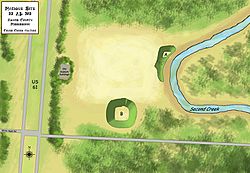Mazique Archeological Site facts for kids

Layout of the Mazique Archeological Site
|
|
| Location | Sibley, Mississippi, Adams County, Mississippi, |
|---|---|
| Region | Adams County, Mississippi |
| Coordinates | 31°24′52.92″N 91°23′18.85″W / 31.4147000°N 91.3885694°W |
| History | |
| Founded | 1000 CE |
| Abandoned | 1730 |
| Cultures | Coles Creek culture, Plaquemine Mississippian culture, Natchez people |
| Site notes | |
| Excavation dates | 1927, 1929, 1948 |
| Archaeologists | James A. Ford, Moreau B. Chambers, John L. Cotter, W. P. Lancaster |
| Architecture | |
| Architectural styles | platform mound, plaza, |
| Architectural details | Number of monuments: 3 temple mounds |
|
Mazique Archeological Site
|
|
| NRHP reference No. | 91001529. |
| Added to NRHP | October 23, 1991 |
The Mazique Archeological Site (also known as White Apple Village) is an ancient place in Adams County, Mississippi. It was once home to people from the Coles Creek culture and later the Plaquemine Mississippian culture.
This site was also the location of the historic White Apple Village, where the Natchez people lived. Today, it is recognized as an important historical spot and was added to the National Register of Historic Places on October 23, 1991.
Contents
What is the Mazique Site Like?
The Mazique site is located next to Second Creek, which flows into the Homochitto River. It had three large platform mounds and a central open area called a plaza.
People lived here during two main periods. First, during the Coles Creek period (from 700 to 1000 CE). Then, during the Plaquemine Mississippian period (from 1000 to 1680 CE).
The Mounds at Mazique
- Mound A: This mound sits right by Second Creek. Over time, the creek has worn away more than half of it. It is now about 8 meters (26 feet) tall. In the past, it was recorded as being taller and wider.
- Mound B: This mound is to the southeast and is about 4 meters (13 feet) tall. It still has its flat top, and there is an old cemetery on it.
- The Third Mound: An early explorer, Montroville W. Dickeson, mentioned a third mound. He said it was smaller and had been flattened by farming. Later surveys did not mention it, so its exact location is still a mystery.
The site is named after a local African-American family who used to own the land.
Exploring the Site: Excavations
Archaeologists have studied the Mazique site several times. These studies are called "excavations," where scientists carefully dig to find old objects and learn about the past.
Early Discoveries
In 1927 and 1929, archaeologists James A. Ford and Moreau B. Chambers visited the site. They collected pieces of Plaquemine pottery. By studying these pieces, they could tell that the site was used during the Coles Creek period.
Later Digs and Challenges
The first major archaeological digs happened in 1940. A local tourism promoter, Jefferson Davis Dickson, Jr., helped start these efforts. He even built a small "archaeological museum" on the site in the early 1940s. Unfortunately, this museum caused some damage to the ancient site.
Later, in 1948, John L. Cotter and W. P. Lancaster also carried out excavations at Mazique.
White Apple Village and the Natchez People
The White Apple Village was an important settlement of the Natchez people. It actually moved to three different locations over time, with the last one being at the Mazique site.
Natchez Politics and European Influence
By the early 1700s, the Natchez people had different groups, or "factions," with different ideas. Some Natchez leaders, like The Great Sun and his brother Tattooed Serpent, were friendly with the French. Their villages were closer to the Mississippi River.
Other Natchez villages, including White Apple, were more friendly with the British. These villages were further east, closer to the Chickasaw people and British traders.
Conflicts and Changes
The White Apple Village often led disagreements with the French. These conflicts were part of older rivalries among different Natchez groups. Sometimes, the main Natchez leadership would even move to different sites because of these rivalries.
- First Natchez War (1716): This war started when people from White Apple attacked French traders. After this, the French built Fort Rosalie nearby.
- Later Conflicts (1722-1723): More fighting broke out when a French trader killed a Natchez villager from White Apple. Even though Tattooed Serpent tried to make peace, the French demanded that a White Apple chief be handed over.
- The Final Conflict (1729): In the late 1720s, the French commander, Sieur de Chépart, ordered the Natchez to leave White Apple. He wanted to use their land for a tobacco farm. This was the final insult.
The chiefs of White Apple reached out to other Native American groups, like the Yazoo and Choctaw. They also invited enslaved Africans on French farms to join them. Together, they attacked French settlements in their territory. This major conflict is known as the Natchez War. In the end, the French responded with force, and many Natchez people were killed or forced to leave their homes.


